Chapter Two
Part Five
| We stay a while with Sunbeam to see
how they fared in the 1913 Coupe de L'Auto and also the
French Grand Prix. First came the Grand Prix on the 13th
June, held at Amiens over 29 laps, a distance of 570 miles.
Of the 20 cars entered for the race the four Sunbeams were
the only British representatives. They had six cylinder
engines with cylinder dimensions of 80 x 150mm. They were
cast in pairs and gave 110b.h.p. at 3,000r.p.m. The cars
included a leather faced cone clutch and a 4 speed gearbox
The 1913 French Grand Prix would be run under a fuel
consumption formula and with this in mind the Wolverhampton
cars had a top speed of around 88m.p.h. Drivers were
Caillois, Dario Resta, Jean Chassagne and K.L.Guiness. First
away in the race was the Sunbeam driven by Caillois,
followed by the others at 1 minute intervals. |
|
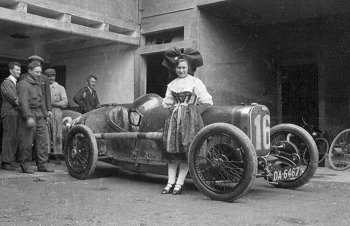
A Sunbeam racing car on display. |
At the end of the first lap, on
corrected time he lay 9th, the leader being
Georges Boillot driving a 5,665c.c. Peugeot that was a good
1,000c.c. plus larger than the Sunbeams. Chassagne, held
third spot and Caillois soon dropped out with steering
problems. Only 12 cars were left in the race by lap 15 and
the positions were Albert Guyot in a Delage, leading from
Georges Boillot in a Peugeot, with the Sunbeam of Chassagne
third. Guiness had a monumental crash in which one spectator
was killed. |
| His car was very badly damaged but he
escaped with only minor injuries. After almost 580 miles of
racing Georges Boillot brought his Peugeot home first at an
average speed of 72.12m.p.h. followed by team mate Jules
Goux, about three minutes down. Jean Chassagne took third
spot for Sunbeam, something like 12 minutes behind the
winner, his being the only Sunbeam to finish the race. |
| The Coupe de L'Auto came on September
21st and for this three cars were prepared. All had four
cylinder 80 x l49mm engines with a capacity of 2996c.c. The
cars were in effect developments of the successful 1912 cars
and would be driven by Chassagne, Guiness and Resta.
Unfortunately the great success would not
be repeated for only Guiness managed to complete the race,
taking third place. |
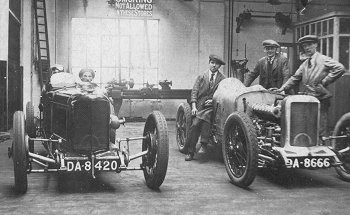
Two Sunbeams at the works in 1924. |
| Both Resta and Chassagne had been
forced out with rear axle troubles, the former’s breaking
after only about 20 miles. Guineas had averaged 61.45m.p.h.
and as well as third prize was awarded the Maurice Thiery
Regularity Prize. |
|
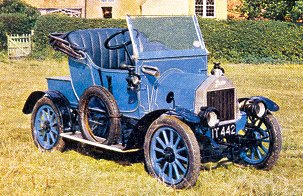
A 1909 Briton. |
During the summer of 1913 Star
suffered a serious fire at their body shops in Dobbs street.
The buildings were destroyed along with several vehicles
being prepared for the Commercial Vehicle Show. The
situation however, was alleviated somewhat by the fact that
part of the Briton Motor Company had now moved into its new
premises in Walsall Street and Star were able to move the
body building department into their vacated shops in Stewart
Street. For a time some star bodies were built by Stuart
Coachbuilding in Green Lane. |
|
On a brighter note, some
records were broken by Star cars during the year. A streamlined
20.lh.p. single seater taking nine class records at Brooklands
including 500 miles at 78.8m.p.h. This particular record being
taken from the Coupe de L’Auto Sunbeam, which must have been
most pleasing to all at Star.
On the production
side twenty cars were supplied to the Roumanian War Office
and a 15/20 was supplied to Prince Aldenburg, a
brother-in-law to Czar Nicholas.
At this time a few
cars were built with bull nose radiators for a leading
London motor agent Charles Friswell, to be sold by him as
'Knight of the Road'. Only a handful were produced but for a
short time Star adopted a rounded radiator on some of their
other cars.
|
|
Incidentally Star also
made a few cars for a Scottish motor agent for sale under the
‘This Thistle’ trade mark, again very few were produced. It will
be remembered that some of the vehicles for the Commercial
Vehicle Show had been destroyed in the fire. Due to this all the
range could not be exhibited. On show were two one ton vans
fitted with pneumatic tyres. They had 15/20h.p., four cylinder
90 x l20mm engines and four speed gearboxes, and were priced at
£310. A 30 to 40cwt chassis was also exhibited but neither the
'Starlet' 8cwt van or the 4 tonner could be shown.
On the private cars
detachable wheels had been standardised and there were now three
basic models, all with four cylinder engines. The 12/15 cost
£350 and the 15.9 long stroke £460. Star had over the past few
years really grown and could now be placed among the top six
motor manufacturers in the country.
The press reported that
although no dividends had been paid for some years, 9% was
predicted for the year 1912 /13. |
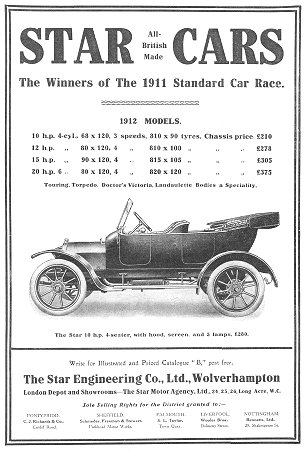
An advert from 1912. |
| Having brought the story up to 1913
we must now again take notice of A.J.S. for during the year
they made their second appearance in the Isle of Man for the
Junior T.T. race. As in 1911 two machines were entered and
would be ridden by Cyril Williams who will feature much more
in this story, and H. Heaton. The 1913 races were of a
different format to previous years in that the race distance
was increased by one 1ap to six for Juniors and seven for
seniors. |
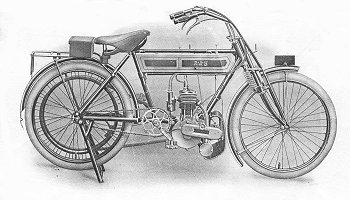 |
The powers that be, considered the
races should each be held over 2 days with the Juniors
required to do 2 laps on the morning of the first day and
the Seniors 3 in the afternoon. Then 75% of the entrants, or
the survivors of the 1st day, whichever were the least,
would participate in the 2nd day’s race in which both
classes would run concurrently and be identified by coloured
waistcoats, blue for the Juniors and red for the Seniors. |
|
The two A.J.S. machines
entered in the Junior were quite standard 298c.c. motorcycles,
although rather ahead of their time were the internal expanding
rear wheel brakes. At the end of the first day’s racing W.
Heaton held 4th place and was the first single cylinder rider in
the first ten. Cyril Williams had a poor race but was among
those to compete on the second day. Right from the start he
struck trouble being delayed for over 2 minutes making
adjustments, and he would not figure at all in the race. However
Heaton held on to his 4th place and moved up to 3rd on lap two,
when trouble struck causing him to be delayed. In fact he had to
mend three punctures during the final laps. None the less he
managed to finish 10th. The race was won by Hugh
Mason riding an N.U.T. at an average speed of 43.75m.p.h.
No doubt the Stevens
brothers would have been pleased with Heaton's plucky
performance but would have realised that they had much to do
if they wished for success in international motorcycle
racing. That they got down to it in no certain way we shall
see later.
With regard to road
machines, A.J.S. had introduced for the 1913 season a side
car machine in the shape of a 6h.p. air cooled ‘V’ twin with
74 x 81mm cylinders, three speed gearbox and all enclosed
chain transmission. It became an immediate success and the
big twin AJ became a very well liked and famous motorcycle,
remaining in production for many years. |
| It was so sturdy that many passenger
machines would eventually be rebuilt, after many years of
use, to carry box sidecars for tradesmen’s tools and deliver
all kinds of goods. Other machines in the range had a
2.75h.p., 74 x 81 mm single engine with two or three speeds
to choice. £46 being asked for the former with an extra
fiver for the three speeder. The 2.75 also became a very
popular mount. |
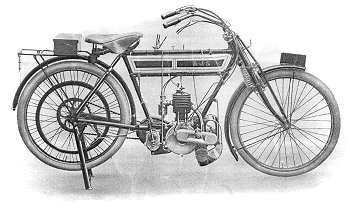 |
| Towards the end of 1912, for the
coming season, Sunbeam had introduced a 3.5h.p. model. It
had a single cylinder 85 x 88mm engine with very deep
cooling fins. The magneto was driven by enclosed gears and a
large central pinion cover was a feature of the model. Much
attention had been paid to silencing and a large silencer
fitted. After all it was the gentleman’s motor bicycle.
Three speed gearbox was fitted with a lever in a car type
gate and all the chains were enclosed in oil bath cases.
Sunbeam like AJS and indeed most manufacturers supported
competition events and in the very tough English Six Days
Trial of 1913 made best solo performance, whilst at
Brooklands, Vernon Busby took second place in his class at a
September meeting. |
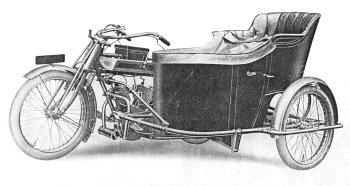 |
Clyno were being kept busy turning
out their excellent big twin sidecar outfits and for 1913
introduced a lightweight machine. The twins had 5/6h.p.
engines with cylinder dimensions of 16 x 82mm and a two
speed gearbox with an all chain drive and free engine
clutch. They were finished in a special silver grey and
lined in blue. The tank was also silver grey with blue
panels lined in gold. |
|
The Clyno two speed gear
was a simple design and foot operated with a separate chain for
each gear. To move off, a pedal was pushed to the rear to engage
the low gear by expanding rings within a drum, and for high gear
the pedal was pushed forward. The outfit was listed at £91 and a
solo machine listed at £75. Clyno did not go in for road racing,
though that it had been considered is proved by the fact that a
racing sidecar outfit had been prepared and entered for the 1913
Grand Prix at Picardie. Illness prevented Frank Smith from
riding and nothing more seems to have been heard of the project.
Clyno did support
trials and were very successful, winning many more awards
than could be listed here. Mention can be made however, of
the sidecar cup from the prestigious London to Edinburgh in
which three Clyno riders took gold medals. |
|
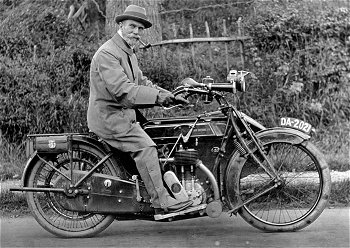
Baruch Beckley on his Sunbeam. |
Another Wolverhampton made big twin
motorcycle was introduced in 1913 when Sunbeam decided to
add one to their range and for this they chose the well
known and popular JAP 6h.p. 16 x 85mm motor. The
specification included a three speed gearbox and all chain
transmission, fully enclosed of course in oil bath cases.
When reviewed in a 'MotorCycling' report they closed with
these words “of the workmanship, general finish and care for
detail it is sufficient to say the machine is a Sunbeam”. |
| Like Clyno Sunbeam had many successes
in trials taking vast numbers of awards and gold medals, and
they were also to be seen in speed events. During the 1913
September Brooklands meeting, Vernon Busby gained second
place in his class.
During 1913, Turner's Motor Manufacturing Company decided to
discontinue steam car production. They had lasted longer
than most, though the Turner steam cars had proved
successful since 1904 and had sold in good numbers. The
directors of the company had foreseen that as the internal
combustion engine became more efficient the steamer would be
at a great disadvantage and that petrol would lead to the
demise of steam. Turner's had of course built a few Seymour
petrol cars back in 1906 and they now brought out what they
claimed to be the first light petrol motor. The car was
powered by a 9h.p. 'V' twin air cooled engine with a two
speed gearbox mounted in a tubular frame and with rather
sketchy bodywork. The following year a 10h.p. water cooled
four cylinder car had been introduced which sold for £185.
We now come to 1914
and the last few months of peace before Europe was plunged
into war. People who really understood international affairs
had for some years known that war with Germany was
inevitable, but the vast majority of folk just would not
believe that it could happen, and though storm clouds were
now on the horizon, most chose to ignore them. Everything
went on as before and during the year there were some very
fine performances by both cars and motorcycles that had been
made in Wolverhampton. |
|
First a look at the
competition side. In March Chassagne was at Brooklands with a 12
cylinder Sunbeam racing car of 9084c.c. His record breaking
spree included one mile in 29.82 seconds, at an average speed of
l20.13m.p.h. and five miles at 114.08m.p.h. In June the soon to
be famous Malcolm Campbell won an 8.5 mile handicap driving a
1913 Coupe de La Auto car at an average speed of 86m.p.h.
During May, two of
the six cylinder Sunbeam Grand Prix cars had been taken to
America for the famous Indianapolis 500 mile race. H. Grant
achieved 7th place at 75.69m.p.h., but Chassagne was
sidelined early on in the race with a burst tyre. There were
of course many, many more Sunbeam successes, far too many to
record here. |
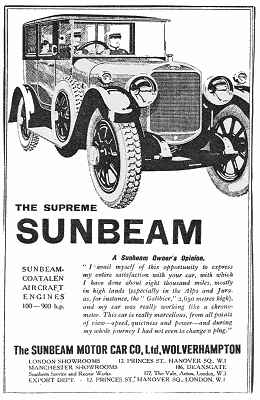 |
|
We will now consider the
great and very important racing successes of Wolverhampton made
vehicles. Towards the end of May came the Auto Cycle Union's
Tourist Trophy Races in the Isle of Man and for the Junior race
there were no less than five A.J.S. machines. The races
had now reverted to one day affairs with the Juniors required to
cover six laps of the mountain circuit, something over 220
miles.
The AJ's were rather
special. The cylinder and pistons were machined from solid
billets of steel and all chain transmission was used. The four
speeds were achieved by fitting a two speed P & M epicyclic gear
and a two speed countershaft. Cylinder dimensions were 74 x
81mm. and the engine capacity was 348c.c. with side valves. The
practice period had shown the Wolverhampton machines to be very
fast indeed. The riders were Cyril Williams and Eric Williams
(not related), Bert Haddock, Billy Jones and W. Heaton. The last
three were seen to be the most competent riders.
It would perhaps be as
well to mention here that T.T. races were, and indeed still are
interval start, so that the first rider on the road on corrected
time may not have been race leader. |
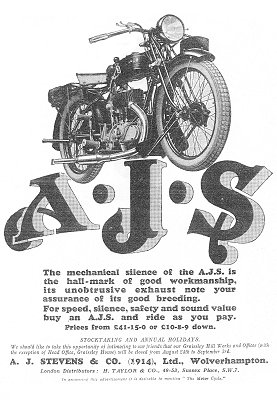 |
At the start of the 1914 Junior T.T.
F.J. Walker on a very fast Royal Enfield twin held the lead
with Eric Williams second and Heaton 4th. On lap three
Walker had a nasty crash which delayed him somewhat and Eric
Williams took over the lead, with Heaton now second, C.
Williams in 5th place and Bert Haddook 6th.
On the next round Cyril Williams had moved up to third spot
putting A.J.S. machines in the first three places with Jones
5th. The Wolverhampton machines were really
dominating the race but it was by no means all over bar the
shouting. Walker had got going again and was fairly cutting
through the field to take third place.
Unfortunately Heaton crashed, hitting the bank on Snaefell,
damaging the front whee1 and forks. He managed to make some
running repairs and carried on but now well down the
field.The race ended with A.J.S. rider Eric Williams first
in 4 hours 6 minutes 50 seconds, an average speed of
45.58m.p.h., a Junior record.
|
| Team mate Cyril Williams came in 4
minutes later and Billy Jones finished 4th, Bert
Haddock 6th, and despite his troubles Heaton came
home in 29th place. What a great result for the
Stevens Brothers, first and second at record speed, plus
record lap at 53.5m.p.h., faster than the best so far by a
Senior machine, and none of the AJ's had retired.
There was a sad note to the race however, indeed tragedy
struck in the closing stages. F.J. Walker after his crash
had come through into third place, but for some reason,
perhaps still somewhat dazed from the accident, perhaps
trying just a little to hard, failed to slow down on taking
the chequered flag and crashed into a barrier. Poor Walker
received severe injuries which were to prove fatal, a sad
end to a most gallant ride.
We are now able to
look at the 19l4 Senior T.T. race for machines of up to
500c.c. Sunbeam were making their T.T. debut, and we can
note that AJS would contest the Junior classes and Sunbeam
the Senior. Three Sunbeams had been entered to be ridden by
works tester Howard R. Davies. Note the initials, they would
become famous on the tank of a very fine motorcycle, as we
shall see in due course. His team mates were Vernon Busby
and Charlie Noakes. In the event the later was unable to
ride and his place taken by another member of the testing
staff Tommy de la Hay, another who would became very famous
indeed.
The machines it goes
without saying were beautiful motorcycles of first class
finish and workmanship and were really standard roadsters
that had been assembled with extra special care. They were
accurately tuned and a modified lubrication system was
fitted.
Though fast, with a
top speed of over 70m.p.h. the Sunbeams were not expected to
win, and indeed the riders had been instructed to ride to
finish, as Sunbeam were desirous to prove the reliability of
their machines in this tough 7 lap race. |
|
In the early stages Tim
Wood led on his Scott and by the third lap the best of the
Sunbeams, that ridden by Davies was down the field in 12th
place, however he now speeded up to such effect that on the next
lap he had come through to 5th spot and was motoring at such
speed that he would finish the race equal second with Oliver
Godfrey on an Indian. The winner proved to be Cyril Pullin on a
Rudge Multi with a time of 4 hours 32minutes 48 seconds, a speed
of 49.49m.p.h., a record. This by the way was the first win by a
single cylinder machine over the mountain circuit. Davies had
finished a little over six minutes behind the winner, whilst
Busby came in 11th and de La Hay 13th.
So Sunbeam had achieved what they set out to do, and proved the
reliability of their machines. They would now of course set
their sights higher, but due to conditions beyond their control
would have to wait a few years to achieve those ambitions.
|
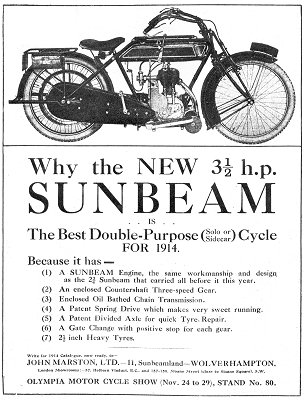 |
|
We remain in the Isle of
Man, for a few weeks after the motorcycle races had finished,
along came the Royal Automobile Club's T.T. race for the four
wheelers. The race had been last held in 1908 and as we have
noted above, Star had contested the event in 1906 and 1907
without success. They did not enter in 1908 but were now back
again for what was to be the last T.T. until 1922. This proved
to be Star’s last T.T. race. Sunbeam motorcycles had made their
island debut a few weeks prior in the T.T. and now Sunbeam cars
made their first T.T. appearance.
The race would be
tough and held over two days. Drivers were required to cover
16 laps of the 37.75 mile mountain circuit, a total of 600
miles. The entry consisted of 22 cars which included two
Stars and three Sunbeams with Richard Lisle and R.F.
Crossman at the wheels of the former and K. Lee Guiness,
Dario Resta, and Algernon Lee Guiness representing Sunbeam.
This was a very strong team indeed.
The Stars which
caused much comment by being painted brilliant red had four
cylinder engines with cylinder dimensions of 90 x 129.5mm,
giving a capacity of 3308c.c. They were known to be fast,
with a top speed in the region of 96mph. |
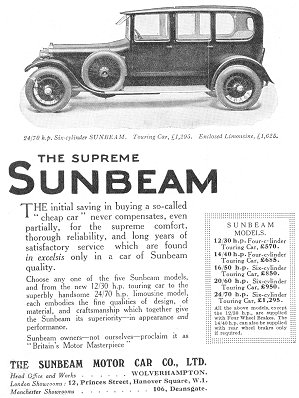 |
The Sunbeams were
perhaps more sophisticated machines, they also had four cylinder
engines but with cylinder dimensions of 81.5 x l60mm, the
longest stroke in the race. This gave a capacity of 3255c.c. and
developed 99b.h.p. at 3,000 r.p.m. A double overhead camshaft
and 16 valve head was fitted, with a gearbox of very light
construction, made of Vickers Vanadium steel, of only 2mm
thickness.
At the end of the practice period the Sunbeams were firm
favourites to win, though many thought the Vauxhalls might
spring a surprise and the Belgian Minervas could not be
discounted. They were a bit unpopular for the clouds of smoke
that their sleeve valve engine produced. Also going well in
practice had been W.O. Bentley driving a D.F.P. Bentley which
would of course become a very famous name in the motoring world.
We shall not be meeting him here, he had no connection with the
local industry, though from time to time he did have the gloves
on with Coatalen in the motoring press. |
|
But now to the race.
During the night proceeding the first day there had been very
heavy rain, none the less an over keen official had spread salt
on the road. This was one of the compounds used for dust
prevention, prevalent at the time, however it prevented the road
drying out for sometime. As it did dry the dust got into the
drivers’ eyes with very painful results. When the race got under
way Sunbeam were soon in trouble for Resta dropped out early on
the first lap with big end trouble. It was soon seen that the
race would be between the Sunbeams and the Minervas, and so it
proved to be. At the end of the first day K.L. Guiness led his
brother Algy with Minervas in third and fourth places. The Stars
faired badly because Crossman had suffered mechanical trouble
and Lisle had crashed to become the only non mechanical
retirement of the race.
The second day
dawned fine as the cars were brought from their overnight
impounding. No work at all had been permitted and now most
drivers had some adjustments to make. When racing started
the two Sunbeams maintained their lead and in fact the
regularity of their running became a talking point amongst
spectators around the course, so that when KLG came through
and Algy did not appear at his expected time there was
something of a sensation. The Minervas had gone through and
it soon became known that the second Sunbeam had retired
with a seized universal joint. The late Sunbeam was harried
by the Minervas but as drivers began the 14th lap with two
to go, Guiness held a lead of 19minutes over C. Rieken in
the leading Minerva. With other Minervas in third and fourth
places there were many changes of position during the last
75 miles, but the leader held his place and K. L. Guiness
brought his Sunbeam in to win the 1914 Tourist Trophy. His
time was 10hours 37minutes 49 seconds, an average speed of
56.44m.p.h., about twenty minutes ahead of C. Riecken' s
Minerva which had made the fastest lap at 59.3m.p.h. Third
place fell to another Minerva driven by Leon Molon with G.
Porporato finishing 5th. Minerva took the team
prize. Only six cars finished this gruelling race. The Daily
Telegraph gave the prizes of £1,000 to the winner, £250 to
the runner up and £300 to the winning team. |
|
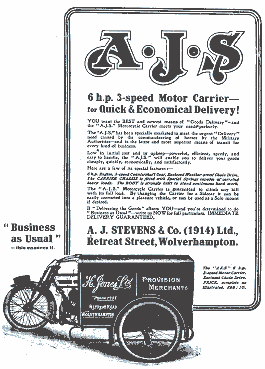
An advert from 1914. |
Well Wolverhampton could
be proud. A.J.S. had won the motorcycle T.T. and Sunbeam had
proved victorious in the car T.T.
Just a few weeks
after the ACU T.T. Cyril Williams was at Brooklands with his
second place A.J.S. for a race over 56 laps, a distance of
150 miles. From the start a battle developed between Len
Bailey on a Douglas and E. Keyte riding a Royal Enfield with
Williams a good third. Bailey soon struck trouble and had to
drop back. By the 18th lap there was much passing and
re-passing for the lead between Keyte and Williams. On lap
29 the A.J.S. man went into the lead which he would not
relinquish and went on to win from Keyte at an average speed
of 53.99m.p.h.
Later at a
Motorcycling Club meeting at Brooklands Bert Haddock won a
350c.c. scratch race for A.J.S. and came second in the two
lap 500c.c. sidecar race. To finish off he was runner up on
a 350c.c. outfit in the Harry Smith Gold Cup race. |
|
The Wolverhampton
motorcycle factories also had lots of trials successes during
the year. Among those of Clyno were a gold in the Jarrott Cup
Contest, highest marks in the Bristol Trial, Gold Medal and
special prize in the Paris - Nice Trial and a class win in the
Wolverhampton and District Auto Club hill climb. These are just
a few of the successes of the big twin Clyno. The new
lightweight also took part in sporting events and did very well.
Clyno gaffer Frank
Smith himself rode in most of the events with great success.
An experiment was made with Sankey artillery wheels for some
of the trials outfits, but they were subject to cracking
when used for the Scottish Six Days. None the less
Hugh Gibson, Frank Smith, G. Nott, G. Wray and the Rev.
Percy Bischoff, who would later work for Sunbeam all took
Gold Medals. The lightweight riders also did well, A.G.
Cocks and Rex Pearson both taking Golds. In all the reports
the Clyno outfits were said to be very impressive on the
hills.
Other Wolverhampton
successes in the Scottish Six Days were on A.J.S. machines.
A. Downie won Gold, Bert Haddock, Silver and Charlie Noakes
won a Gold with Vernon Busby taking one of the two Sunbeam
Silvers.
Now a look at what
the Wolverhampton firms were offering to the public, and has
we have not for sometime considered Wolf we shall start
here.
|
| For the 1914 season Wulfruna
Engineering of Great Brickkiln Street, previously the
Wearwell Motor Carriage Co., with works in Pountney Street
that were taken over by Star, offered a range of machines
under the Wulfruna trade mark. The range included
motorcycles from 2.5h.p. singles to an 8h.p. twin. Two
single cylinder models used the Wulfruna engine which had
inlet over exhaust valve layout.
|
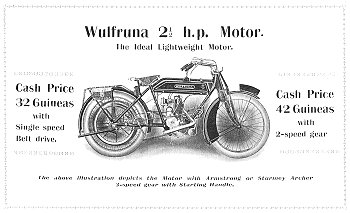 |
| The cylinder dimensions were 76 x
65mm with a capacity of 298c.c. and could develop
2.5h.p. at 4,000r.p.m.
A side valve of 499c.c. was also
listed costing 53guineas (£55.65.) with two speed
countershaft, or 2guiineas (£2.10.) if fitted with a
three speed hub. The big twins had the popular JAP ‘V’
twin engines of 6h.p. (770c.c.) and 8h.p. (996c.c.) and
were fitted with belt drive or fully enclosed chain
drive. The 8h.p. with two speed gear cost 72 guineas
(75.60). All machines were enamelled black with green
tanks lined in gold. Wulfruna also offered sidecars
priced from ten guineas (£10.50) to £14.10s.0d.
(£14.50). The1914 catalogue carried pages of the usual
unsolicited testimonials and these came from places as
far afield as Paris, Durban and Dublin as well as from
this country and include one of praise from H.E.
Williams of Waterloo Road, Wolverhampton and one from
C.E. Noakes of Lea Road who had won a silver medal for
riding his Wulfruna non stop on the Bristol Motorcycling
Club’s open trial.
A range of 5 machines
was offered by A.J.S. and they included big twins but with their
own engines. The 74 x 81mm 6h.p. 'V' twin had a three speed
countershaft gearbox. The solo cost £73.10s.0d. (£73.50.) and
the combination sold for £88.5s.0d. (£88.25). All other models
were 74 x 81mm singles and cost from £49.10s.0d. (£49.50) to
£52.10s.0d. (£52.50).
On the car side Sunbeam
offered three models, the 12/16, 16/20 and 25/30, the later a
six with cylinder dimensions of 90 x 160mm and a capacity of
6105c.c. It was priced at £670. The four cylinder 16/20 shared
the bigger car’s engine dimensions giving 4070c.c. and it sold
for £535. The 12/16 had four cylinders of 80 x 150mm and a
capacity of 3016c.c., costing £390. All had Claudel carburettors
and the two larger models included dual ignition.
|
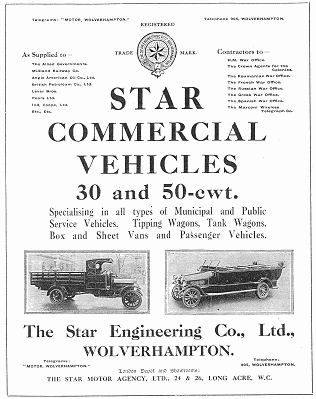 |
Now what of Star during
1914. The Presto Gear Case Company which Star had owned since
1896 was voluntarily wound up. The Star factory was fully self
contained having its own foundry, cupola and plating shops as
well as facilities for crankshaft balancing. It was the only
firm in. the district with this equipment, it proved useful to
Sunbeam who among other things used it to balance their aero
engine cranks.
The Star range of
cars were all four cylinder. The 10/12, 12/15 and 15.9 all
had cylinder dimensions of 80 x l20mm, the smaller engine
having cylinders cast on block the others in pairs. All had
a leather faced cone clutch and shaft drive. They ranged in
price from £300 to £385. The 20.1h.p. had cylinder
dimensions of 90 x 150mm and cost £460. Star also offered a
range of commercial vehicles. |
|
Associated company the
Briton Motor Company, which turned out lighter, cheaper versions
of the Star offered four cylinder models with cylinder
dimensions of 66 x 130mm for just ten bob (50p) under £200. The
range included an 80 x l20mm four, 15.9h.p. at £236.5s.0d.
(£236.25). These are chassis prices, complete Britons cost
between £68 and £130 extra.
Briton like Star also
offered commercial vehicles, though they made very few. The
10/12h.p. twin 98 x 120mm 5cwt cost £155 and a 7cwt four
cylinder 68.8 x 120mm was listed at £155.
On August 4th England
was at war with Germany, very many people thought it would all
be over by Christmas. They were soon to be disillusioned of
course, but at first things carried on much as before. New motor
cars and motorcycles were still being produced and were
available in the showrooms. Even motor sport carried on for some
time, however that will come in the following chapter.
We now consider a
new and to be very famous marque that was born a short time
before hostilities broke out. As noted above Sidney Guy was
works manager at Sunbeam, having held that position since
1909, he now decided to set up on his own account to
manufacture commercial vehicles. He was perhaps a little
unlucky in his timing for within a few months the country
was at war and only few vehicles had been made when the
factory went over to war work.
|
| They had some rather advanced
features however. The first vehicle to carry the Guy name
was a 30cwt lorry which had direct drive on third gear and
what would now be called overdrive on top. The four cylinder
80 x 130mm 15.9h.p. White & Poppe engine had a cone clutch
and shaft drive. Twin tyres were fitted at the rear and were
solid as were the ones at the front. This vehicle sold for
£435. A few two tonners were also produced prior to the
outbreak of war, very much the same as the smaller vehicle.
It was listed at one hundred pounds more. A very good
feature of these lorries was that the engine was in a sub
frame with three point mounting to the chassis to prevent
distortion of the engine and gearbox when traversing rough
ground. Guy of course became
famous for its public service vehicles and as early as 1914
a few were turned out. One, a 14 seater charabanc gave good
service in the Scottish Highlands. |
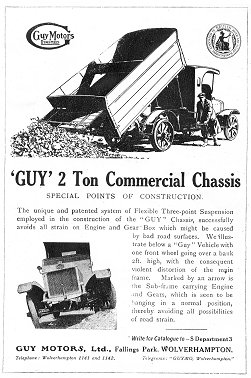 |
|
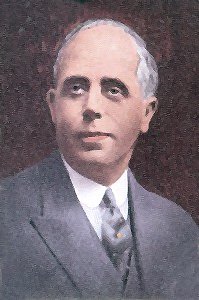
Hamilton McArthur
Hobson. |
Before finally closing this chapter
mention should be made of Hobsons, a well known
Wolverhampton company making parts for the aircraft and
motor industry. We have earlier mentioned the Claudel
carburettor fitted to Sunbeam cars. Way back in 1903
Hamilton McArthur Hobson founded his own business as an
agent selling cycles and accessories with very small
premises in London. Soon he added cars to his lines and at
the 1901 Olympia Motor Show a Nagant Hobson car was shown
and amongst the customers was Sir Harry Lauder. However
Hobson's big success came from the import of Pognon sparking
plugs from France. In 1908 an agency was obtained for the
Claudel carburettors. They were most excellent
instruments and also of French Manufacture. At first these
were imported, but later a licence was acquired to
manufacture in England. As mentioned above Sunbeam were
interested and the board of that company suggested a small
factory in Cousins Street off the Dudley Road, not all that
far from the Sunbeam factory. |
|
After some consideration
by the boards of both firms these premises were rented and
during May 1911 Accuracy Works Ltd was established. Quite soon
afterwards the premises were bought for £825.
From the very start this
enterprise proved a success, but then suffered from lack of
orders so that early in 1914 workers began to be laid off. Then
came the war bringing great demand for Hobson’s products. The
Claudel carburettor was about the best for aeroplane engines and
the company was now able to expand and continued to do so.
Finally the large office block was erected on the Birmingham New
Road during 1936. Once again war gave Hobsons a boost, but their
work was now outside the scope of this book. It can be mentioned
however that they are now part of the great Lucas Aerospace
Company with extensive modern works at Fordhouses. |
 |
|
 |
Return to
Part 4 |
|
Return to
the beginning |
|